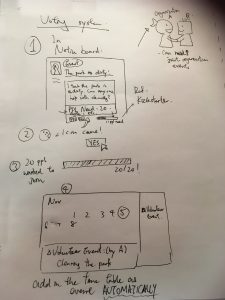Week 6
While we have settled on the function of the webpage, we will be focusing to demonstrate the voting system and the volunteer point system in the storyboard.

The voting system is a function for basic members to create their event on their own via Notice board. When they choose the ‘event’ categories in the notice board, they may be able to uphold their own event concerning no matter what. For example, in the above picture, a resident may be unsatisfied with a dirty park. He may send a post recruiting volunteers to clean it up. By inserting a number of minimum participants need (e.g. 20 people need here), the event will be created automatically on the calendar when 20 interested participates click ‘yes’ in the post. This save works in administering and can allow people to have a first try in participating in volunteering without processing a lot of registering process that gives pressure on them.

Another storyboard showing is one demonstrating how the volunteer point system works.
Volunteer points can be earned through holding and participating events. We try to make the online points to have an actual benefit in real life so as to encourage the community to involve in it. There are three major ways to use it:
- It can act as a counter for organization to know how active a participate in the community. It somehow works as an online cv, but more informal one to show some organization in the site who are potential volunteers or employee.
- When the points continuously add on, participates may unlock achievement and level up as higher level members to have higher authority (like admin) to edit post etc. Achievement may include exchanging for volunteer hours on CV in certain rate. (1 :1 may do also).
- By cooperating with business we can offer discounts through exchange points. (may involve another unit for exchange since the volunteer hours should not be gone when you purchase anything)
Both story boards are just showing the basic concept and may not be complete and thorough enough. We will continue to try editing for the final output.
Hi team, excellent start on a draft for your story board… As you say you are outlining your basic concept and it is not yet the final version. That’s fine and gives a good insight into the development of your solution concept. Please do go read the paper on blackboard for advice on story boards and make sure that your story board outlines a sequence of steps a relevant audience member would take. You may for example focus on a specific volunteer, a specific volunteering organisation, and a specific activity that they are organising… Outline how your system would work within this context so that the story is clear. It should also be clear how the volunteer gets involved, what they gain, and how the prototypes you develop work in across the contexts the story board includes. It would also be good to see exactly how the solution you develop embeds with the volunteers and volunteering organisations everyday life. For example we discussed the challenges of engaging with those without Internet access. You had some ideas how to overcome this barrier and involve them through a card / physical device, perhaps.
After you finalise your story board (which would be part of the final submission) it should also be clearly argued what part of the system you plan to prototype and test. Choose the most important aspect to prototype in respect to the questions and goals you set in W1 (revisited also in W5 after conclusion of background research).
As a note for your design log entries… These should be reflective on your process… In the final submission, please consider how these story boards came to be. For example, you may have had internal team discussions about off-line on-line challenges. You also discussed about the calendar. The log is an opportunity to work through these challenges / disputed and explain how you overcome those. This may also include a discussion of lecture material and conversations with teaching staff about your story board. All these things are good to reflect on somewhat critically to outline your process.